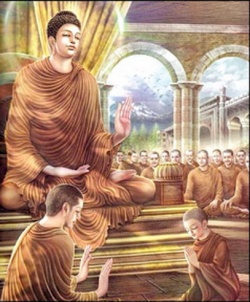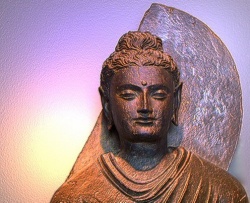Difference between revisions of "Dhatusena"
m (1 revision: Robo 2.48 15 septmeber replacetext) |
|||
| (2 intermediate revisions by 2 users not shown) | |||
| Line 3: | Line 3: | ||
1. [[Dhatusena]] - A [[householder]] of Nandivapigama, father of {{Wiki|Dathanama}}. Cv.xxxviii.14. | 1. [[Dhatusena]] - A [[householder]] of Nandivapigama, father of {{Wiki|Dathanama}}. Cv.xxxviii.14. | ||
| − | 2. [[Dhatusena]] - King of Ceylon (460-78 A.C.). He was the son of [[Dathanama]] and brother of [[Silatissabodhi]]. He seems to have had another brother, [[Kumarasena]] (q.v.). [[Dhatusena]] belonged to the Morjyavamsa. He became a [[monk]] under his uncle, the incumbent of Dighasandasenapati parivena, and remained with him till preparations for his campaign were made. Then he returned to the lay [[life]], killed the {{Wiki|Pandyan}}, {{Wiki|Tiritara}}, then reigning at {{Wiki|Anuradhapura}}, and became king. His chief work was the construction of the | + | 2. [[Dhatusena]] - King of Ceylon (460-78 A.C.). He was the son of [[Dathanama]] and brother of [[Silatissabodhi]]. He seems to have had another brother, [[Kumarasena]] (q.v.). [[Dhatusena]] belonged to the Morjyavamsa. He became a [[monk]] under his uncle, the incumbent of Dighasandasenapati parivena, and remained with him till preparations for his campaign were made. Then he returned to the lay [[life]], killed the {{Wiki|Pandyan}}, {{Wiki|Tiritara}}, then reigning at {{Wiki|Anuradhapura}}, and became king. His chief work was the construction of the Kalavapi, which he carried out by damming the Gonanadi. He built eighteen [[viharas]] and eighteen tanks. He showed great favour to the [[monks]] and did many works of piety. The [[Ambatthala]] [[vihara]] he gave to the [[Dhammarucikas]]. |
He had two sons - [[Moggallana]] and [[Kassapa]]. [[Kassapa]] rebelled against his father at the instigation of his brother in law who had been punished for ill treating the kings daughter - and seized [[Dhatusena]] in the hope of securing his treasure. The king asked to be taken to {{Wiki|Kalavapi}}, saw the [[Thera]] who had been his [[teacher]], and announced that his whole treasure was the {{Wiki|Kalavapi}}. [[Kassapa]] then had him buried alive. | He had two sons - [[Moggallana]] and [[Kassapa]]. [[Kassapa]] rebelled against his father at the instigation of his brother in law who had been punished for ill treating the kings daughter - and seized [[Dhatusena]] in the hope of securing his treasure. The king asked to be taken to {{Wiki|Kalavapi}}, saw the [[Thera]] who had been his [[teacher]], and announced that his whole treasure was the {{Wiki|Kalavapi}}. [[Kassapa]] then had him buried alive. | ||
| Line 16: | Line 16: | ||
Early [[life]] and becoming king | Early [[life]] and becoming king | ||
| − | [[Dhatusena]] was the son of [[Sangha]], the daughter of King [[Mahanama]] who ruled from 410 to 432 A.D. The country was invaded in 433 A.D. by six {{Wiki|Tamil}} leaders from South | + | [[Dhatusena]] was the son of [[Sangha]], the daughter of King [[Mahanama]] who ruled from 410 to 432 A.D. The country was invaded in 433 A.D. by six {{Wiki|Tamil}} leaders from {{Wiki|South India}}, known as the {{Wiki|six Dravidians}}. They overthrew the [[Sri Lanka]]'n {{Wiki|monarch}} and ruled the country for twenty six years, from 433 to 459 A.D. During this time, Sinhalese leaders abandoned Rajarata and fled to the Ruhuna principality in the south of the country. Ruhuna was used as the base for resistance against the invading rulers. |
[[Dhatusena]] was raised by his uncle, a [[Buddhist monk]] named [[Mahanama]]. The Pandyan invaders were searching for [[Dhatusena]], and his uncle [[ordained]] him as a [[Buddhist monk]] to disguise him. [[Dhatusena]] later organised a resistance movement against the {{Wiki|Tamil}} invaders and led a rebellion against them. [[Dhatusena]] claimed the kingship of the country in 455. By the time [[Dhatusena]] started the rebellion, three of the six Pandayn invaders were already [[dead]], and in the battles that occurred during the rebellion, two more were killed. The final battle took place in 459, where the last king, {{Wiki|Pithiya}}, was killed. Having successfully defeated the Pandyan invaders, [[Dhatusena]] was crowned as the king of [[Sri Lanka]] in 459 A.D, taking {{Wiki|Anuradhapura}} as his capital. | [[Dhatusena]] was raised by his uncle, a [[Buddhist monk]] named [[Mahanama]]. The Pandyan invaders were searching for [[Dhatusena]], and his uncle [[ordained]] him as a [[Buddhist monk]] to disguise him. [[Dhatusena]] later organised a resistance movement against the {{Wiki|Tamil}} invaders and led a rebellion against them. [[Dhatusena]] claimed the kingship of the country in 455. By the time [[Dhatusena]] started the rebellion, three of the six Pandayn invaders were already [[dead]], and in the battles that occurred during the rebellion, two more were killed. The final battle took place in 459, where the last king, {{Wiki|Pithiya}}, was killed. Having successfully defeated the Pandyan invaders, [[Dhatusena]] was crowned as the king of [[Sri Lanka]] in 459 A.D, taking {{Wiki|Anuradhapura}} as his capital. | ||
Latest revision as of 19:55, 14 September 2013
1. Dhatusena - A householder of Nandivapigama, father of Dathanama. Cv.xxxviii.14.
2. Dhatusena - King of Ceylon (460-78 A.C.). He was the son of Dathanama and brother of Silatissabodhi. He seems to have had another brother, Kumarasena (q.v.). Dhatusena belonged to the Morjyavamsa. He became a monk under his uncle, the incumbent of Dighasandasenapati parivena, and remained with him till preparations for his campaign were made. Then he returned to the lay life, killed the Pandyan, Tiritara, then reigning at Anuradhapura, and became king. His chief work was the construction of the Kalavapi, which he carried out by damming the Gonanadi. He built eighteen viharas and eighteen tanks. He showed great favour to the monks and did many works of piety. The Ambatthala vihara he gave to the Dhammarucikas.
He had two sons - Moggallana and Kassapa. Kassapa rebelled against his father at the instigation of his brother in law who had been punished for ill treating the kings daughter - and seized Dhatusena in the hope of securing his treasure. The king asked to be taken to Kalavapi, saw the Thera who had been his teacher, and announced that his whole treasure was the Kalavapi. Kassapa then had him buried alive.
Among Dhatusenas gifts is mentioned that of one thousand gold pieces spent by him for an interpretation (?) of the Dipavamsa (dipetum Dipavamsam). Cv.xxxviii.14f, 30ff.
3. Dhatusena - A vihara. See Uttaradhatusena.
Dhatusena was a king of Sri Lanka who ruled from 455 to 473 A.D. He was the first king of the royal Maurya dynasty of Sri Lanka. In some records, he is also identified as Dasenkeli. Dhatusena reunited the country under his rule after twenty six years, defeating the South Indian invaders that were ruling the country at that time. Dhatusena made eighteen irrigation tanks, a large irrigation canal known as Yodha Ela, and the Avukana statue, a large statue of Lord Buddha.
Early life and becoming king
Dhatusena was the son of Sangha, the daughter of King Mahanama who ruled from 410 to 432 A.D. The country was invaded in 433 A.D. by six Tamil leaders from South India, known as the six Dravidians. They overthrew the Sri Lanka'n monarch and ruled the country for twenty six years, from 433 to 459 A.D. During this time, Sinhalese leaders abandoned Rajarata and fled to the Ruhuna principality in the south of the country. Ruhuna was used as the base for resistance against the invading rulers.
Dhatusena was raised by his uncle, a Buddhist monk named Mahanama. The Pandyan invaders were searching for Dhatusena, and his uncle ordained him as a Buddhist monk to disguise him. Dhatusena later organised a resistance movement against the Tamil invaders and led a rebellion against them. Dhatusena claimed the kingship of the country in 455. By the time Dhatusena started the rebellion, three of the six Pandayn invaders were already dead, and in the battles that occurred during the rebellion, two more were killed. The final battle took place in 459, where the last king, Pithiya, was killed. Having successfully defeated the Pandyan invaders, Dhatusena was crowned as the king of Sri Lanka in 459 A.D, taking Anuradhapura as his capital.
Services as king
Dhatusena built eighteen irrigation tanks in order to develop agriculture in the country. Among these tanks are the Kalavewa and Balaluwewa, which are interconnected and cover an area of 6,380 acres (2,580 ha).
He also constructed the Yodha Ela, also known as Jayaganga, an irrigation canal carrying water from Kalawewa to Tissawewa tank in Aunuradhapura.
The Avukana statue, a 13-metre (43 ft) high statue of Lord Buddha, is also a creation of Dhatusena.
Death
Dhatusena had two sons, Moggallana I and Kashyapa I. Moggallana was the son of the royal consort and the rightful heir to the throne, while Kassapa was born to a non-royal concubine. Dhatusena’s daughter was married to his sister’s son and the general of his army, Migara. Following an argument between his daughter and sister, Dhatusena ordered his sister to be killed. In reprisal, Migara encouraged and assisted Kassapa to overthrow the king and take the throne. Kassapa eventually rebelled against Dhatusena and overthrew him. Dhatusena was imprisoned and Kassapa became the king of the country in 473 A.D.
Migara led Kassapa to believe that Dhatusena had hidden treasures of great wealth and persuaded him to find these. When asked to lead Kassapa to where these treasures were hidden, Dhatusena led him to the Kalavewa and taking water into his hands, claimed that this was the only treasure he had. Enraged at this, Kassapa had him killed by burying him alive in the bund of the Kalaweva.

